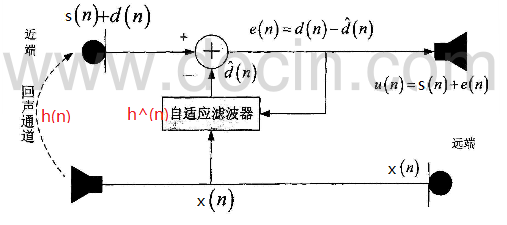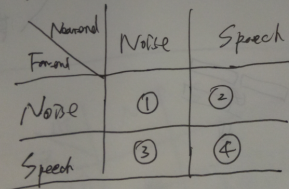LearningWebRTC: AECM
AECM(Acoustic Echo Control for Mobile)是WebRTC专为Android系统设计的低运算量的回声消除模块。 iOS系统自带的回声消除模块一般性能优良,不需要使用应用层的;Windows由于运算量充足,一般使用AEC/AEC3模块。
算法原理
AECM算法的核心是Adaptive Filter,运用的是NLMS(Normalized Least Mean Square) + Wiener Filter结合的方法。 NLMS主要用于估算回声能量谱,Wiener主要根据回声能量谱计算最终结果。
NLMS原理

- Known: farend x(n), nearend s(n) + d(n), where d(n) is the real echo
- Target: estimate adaptive filter h^(n), so that to estimate echo d^(n)
- Cost function: L is the filter length

- Iteration result after the n’th iteration

- should only updates when nearend speech s(n) is silent
- Freq domain(WebRTC used): the same (from 《现代信号处理》P195 张贤达)
Wiener Filter原理

Wiener滤波器同样使用均方误差最小作为优化目标,不过Wiener滤波不使用迭代解,而是显示解:
结合AECM场景,可以简单推到得到,基于NLMS噪声估计的传递函数为:
- H = Syx/Sxx = Ss(s+d)/S(s+d)(s+d) = Sss/(Sss+Sdd) = 1 – Sdd/(Sss+Sdd) = 1 – echoEnergy/nearendEnergy
- AECM会在echoEnergy前乘以一个”置信度” suppressGain,表示的是回声估计越准确,“置信度”越高。
关键步骤

- 使用Hanning窗的DFT变换
- 防止频谱泄露
- delay estimate
- 目标: AECM里,delay一共有三段,farend Playout delay + echo path delay + capture delay,
其中playout和capture由外面提供,这里主要估计echo path delay。
- AECM在频域做,因此最小延迟单位为一个block(64samples = 4ms),默认支持最大延迟为100block,即400ms。
- 方法: 分别求远端信号和近端采集信号的二值谱,并根据二值谱的相似程度(XOR后1的个数)进行匹配。
- 目标: AECM里,delay一共有三段,farend Playout delay + echo path delay + capture delay,
其中playout和capture由外面提供,这里主要估计echo path delay。
- Farend VAD检测 & DT检测:

- 作用:
- 只有区域③允许更新滤波器系数,其他区域必须停止更新(即NLMS stepsize=0);
- 根据farendVAD和DT结果,决定Winer滤波”置信度“(suppressGain).
- AECM里没有显式的检测DT,而是根据large variations in estimated echo来判断DT的存在
- 作用:
- Adaptive Filtering
- 迭代更新NLMS滤波器系数,估算回声能量谱
- 计算Winer滤波器系数,并使用NLP(Non-Linear Process)限幅。
- CNG(Comfort Noise Generator)
- 原因: Winer filter抑制回声时,也抑制了噪声,需要补回来
- 幅度谱根据nearend能量估计,相位谱为均匀分布; 然后算出实部虚部值,加到Winer滤波的结果里
- DFT加窗反变换
可能的优化方法
- 延迟估计是否准确,最大延迟是否超过代码的限度
- echo路径变化时,如插拔耳机,是否对滤波器做了重新收敛
- 提高near VAD + double talk检测准确性。
- 强制用AEC/AEC3替换AECM
评价指标
- ERLE(Echo Return Loss Enhancement)
遗留问题
- 为什么不能只用NLMS?
参考
- WebRTC M59源码
xjs.xjtu@gmail.com
2017-07-05
